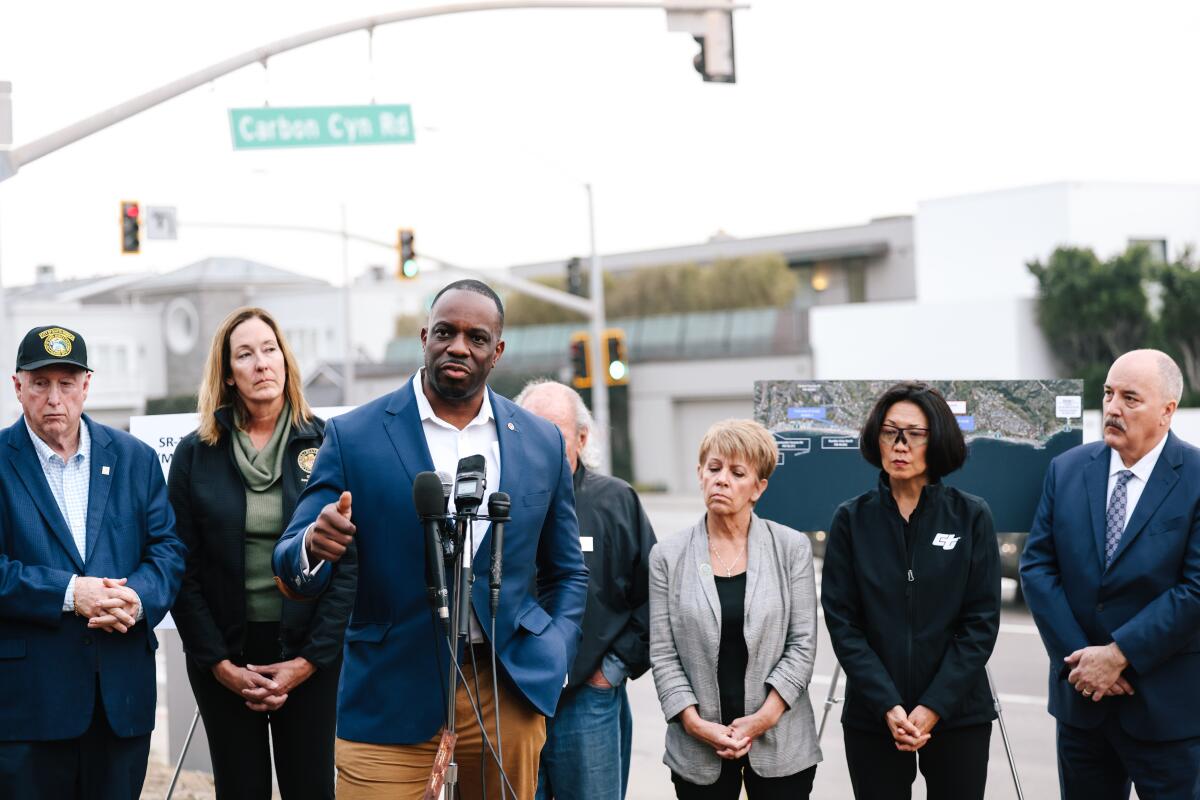Months after horrific crash, Malibu’s PCH is set for safety fixes. Will it be enough?

- Share via
On a dangerous stretch of Pacific Coast Highway known to Malibu locals as “Dead Man’s Curve,” the memory of four Pepperdine University students killed in a horrific crash looms large. After decades of calls to improve the thoroughfare’s safety, advocates wonder whether the October collision could finally spur meaningful change.
Less than a mile from the site of the crash — in which prosecutors said the 22-year-old driver was going as fast as 104 mph — local and state transportation officials gathered Monday to discuss safety upgrades to the 21 miles of the highway that wind through Malibu.
A $4.2-million contract approved last week will allow Caltrans to move forward on a draft list of 30 upgrades, California Transportation Secretary Toks Omishakin said — including enhanced striping in curves, optical speed bars (stripes spaced at gradually decreasing distances to make drivers aware of their speed), speed feedback signs, speed limit markings on the pavement and replacement of safety corridor signs.
While there is a process each project will have to undergo, “this is not a ‘business as usual’ approach,” Omishakin said as cars whizzed past.
After several deadly pedestrian crashes that roiled Malibu and sparked calls for change, business as usual won’t be enough, transportation activists said. Damian Kevitt, founder of Streets Are for Everyone, told The Times the “design of PCH through Malibu is simply and clearly deadly.”
“It needs to be a transformed from a highway where people can do 60 to 80 to even 100 mph through residential [areas] and businesses, with families and cyclists, unprotected, just a couple feet away,” Kevitt said.
Changing traffic lights to slow cars
Long-sought improvements at the local level are also underway. During the first week of December, crews began installing communication lines that will allow Caltrans to remotely control traffic signals on the highway, synchronize their timing and adjust them to lower traffic speeds and reduce congestion.
The new equipment will capture real-time traffic data and send it to controllers who can adjust signal timing so that vehicles going over the speed limit will encounter red lights, while those going the speed limit will encounter green lights — ultimately reducing the flow of speeding traffic.
The $34.6-million yearlong project will also include new closed-circuit TV cameras at each intersection, street improvements and accessibility upgrades and changeable message signs. It was fully funded by Measure R funds administered by the Los Angeles Metropolitan Transportation Authority.
The project was approved seven years ago, but because the highway is under California Department of Transportation jurisdiction, it had to be reviewed by the state.
“The Caltrans review process, while undoubtedly necessary for ensuring regulatory compliance and safety standards, proved to be more cumbersome than anticipated,” said Matt Myerhoff, Malibu’s public information officer.
A series of reports that had to be filed sequentially per Caltrans guidelines were delayed over a year in total, according to the city; Myerhoff said that had the process not been held up, the project would have been completed by the spring of 2020.
“We understand the complexities involved in regulatory procedures and acknowledge Caltrans’ commitment to public safety,” Myerhoff said. “However, we believe that a thorough review of the specific circumstances surrounding the signal synchronization project could shed light on areas where the process might be optimized without compromising safety and quality.”
Such projects are common for cities looking to improve traffic safety.
On a smaller scale, the city of South Gate is nearing completion on its traffic signal synchronization project on Tweedy Boulevard, a straight roadway, that started in the spring.
Since the inception of the 1988 Los Angeles Countywide Traffic Signal Synchronization Program, 54 projects have been completed in an attempt to enhance traffic flow along key transportation corridors in unincorporated areas, said Celeste Hampton, public information officer for L.A. County’s Department of Public Works.
But none of these projects compare to the challenge of making the winding highway in Malibu safer.
A deadly road to seaside paradise
While traffic accidents are on the decline statewide, serious crashes along Malibu’s portion of PCH are becoming more common.
Data from the California Highway Patrol comparing the week of the October collision to the same week in 2019, 2020, 2021 and 2022 show that the number of crashes statewide was down around 10% in 2023. Crashes causing death or significant injury were down almost 50% over the average of the previous four years, despite similar numbers of vehicle miles traveled in each period.
But a Times analysis shows that despite scattered safety improvements over the years, PCH has gotten more dangerous. There were 170 deaths and serious injuries to drivers, passengers, cyclists and pedestrians between 2011 and 2023, and the numbers rose every year from 2018 through 2022.
In Los Angeles County as a whole, pedestrian fatalities rose amid an overall increase in fatal crashes from 2018 through 2022. Data for 2023 are not yet available.
At a special public meeting of a PCH task force on Nov. 14, L.A. County Sheriff’s Capt. Jennifer Seetoo, who works at the Malibu/Lost Hills station, detailed the dangers of speeding.
In 2023, there were 127 property-damage collisions, 93 injury collisions and three fatality collisions that resulted in seven deaths, Seetoo said; a primary factor in all incidents was speed.
The week of the meeting, Seeto said, a sergeant on patrol caught an 18-year-old driver going 96 mph on PCH.
“As [the sergeant] tried to meet up with [the driver], all he could see was a plume of smoke,” Seetoo said.
The driver crashed, and the car rolled multiple times, then caught fire. Seetoo said the sergeant had to reach into the car to save the driver.
“We need parents to talk to their kids about the dangers of PCH, and parents — maybe instead of giving them the keys to a sports car, give them keys to the minivan,” Seetoo said.
Caltrans role in Malibu’s PCH
In addition to the highway improvements, many frustrated neighbors want speed cameras, a speed limit reduction and more sheriff’s deputies and California Highway Patrol officers policing PCH.
In mid-November, the City Council declared a local emergency, allowing the city manager to quickly approve a short-term contract with the CHP to immediately bolster interim patrols with officers volunteering for overtime. There have not been regular CHP patrols in Malibu since the city was incorporated in 1991.
The L.A. County Sheriff’s Department and the CHP will work together to ensure that the additional patrols occur during the days and times when they are most needed, and Malibu is working on a long-term contract for permanent CHP patrols, which are expected to go into effect in January.
Caltrans has also been assessing opportunities to reduce the posted speed limit, department official Rafael Molina said.
Immediate actions include optical speed bars, a road safety audit and speed feedback signs.
In the long term, Caltrans is looking at whether PCH can be designated as a safety corridor, a section of road that is high priority for improvements due to the number of serious collisions that occur there. In such corridors, drivers who are ticketed for going over the speed limit pay double the fine.
Members of Seetoo’s Fix PCH Action Team, including Kevitt, say the seven years it took Caltrans to allow Malibu to begin the signal synchronization project “doesn’t indicate that Caltrans is prioritizing safety at all.”
Collecting and studying the data could mean “years and years more delay before they even decide if they can slow down this highway that is known to be deadly,” Kevitt said.
Chris Wizner, another action team member, told The Times he wondered how many more deaths it would take for Caltrans to slow down PCH.
Michael Comeaux, a Caltrans spokesperson, said that the agency’s “top priority is safety, and Caltrans continues to develop numerous projects on PCH in coordination with the city of Malibu and other project partners to maintain and enhance the highway for the safety of residents, businesses, workers and people who seek access to beaches.”
But even with safety improvements, he said, the public’s help is key.
“We remind motorists that it is essential to slow down when driving through neighborhoods,” Comeaux said, “and to always obey traffic safety laws.”
More to Read
Sign up for Essential California
The most important California stories and recommendations in your inbox every morning.
You may occasionally receive promotional content from the Los Angeles Times.















